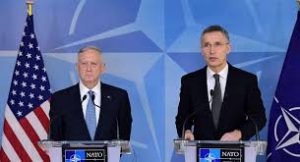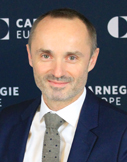Nor has Trump pursued his campaign pledge to make a deal with Russia on the fight against the self-proclaimed Islamic State. The idea of U.S.-Russian cooperation is worthy in principle but has alarmed many in Europe because of fears that Moscow would demand a free hand in Eastern Europe in return. Rather than a grand bargain with Moscow, more U.S. troops and tanks seem to arrive each week to bolster NATO countries bordering Russia.
Perhaps most auspiciously for the alliance’s senior civilian leader, European defense spending in Europe—the most neuralgic of the issues dividing the United States and Europe—is going up. The secretary general will tell the president that budgets in Europe grew by 3.8 percent, or $10 billion, in 2016.
It would be too early, however, to declare the U.S.-European defense relationship safe and sound, for three reasons.
First, while it is important that the U.S. vice president, secretary of defense, secretary of state, and national security adviser all support NATO—and have taken the time to visit (or plan to visit) the Brussels headquarters to say so in person—one important uncertainty remains. Trump seems to regard NATO as a bad deal for the United States, with Washington spending too much money for something—the security of Europe—that lies outside America’s vital interests. This core belief that wealthy allies, not only in Europe but also farther afield, free ride on and laugh at the United States has appeared consistently in Trump’s statements, from a 1987 ad in the New York Times to his 2017 inaugural speech.
The uncertainty at the top matters. In times of crisis, the U.S. president makes the final decision. And presidents have been known to ignore the views of their senior principals, most recently in September 2013, when then U.S. president Barack Obama chose to disregard advice to launch strikes against Syria after the government of President Bashar al-Assad had dropped sarin gas on the suburbs of Damascus. As long as Trump does not believe that the alliance with Europe works to America’s advantage, the allies will not be certain that he would defend NATO in a crisis.
Second, when Trump meets other heads of state and government at a NATO summit in Brussels in late May, they risk having a divisive debate on how to fight terrorism. The United States has asked the alliance to do more but failed to specify what—or even to announce the results of its own review of national strategy to combat the Islamic State. Many European allies suffer from terrorism even more than the United States and agree that NATO ought to do more. Some also look to a joint U.S.-European counterterrorism campaign under the NATO flag to boost Trump’s interest in NATO. But the allies expect the United States to make the first move: the Washington-led global coalition remains by far the bigger player in the fight against the Islamic State, and NATO can hardly produce a strategy compatible with the coalition’s until the White House spells out how it plans to revamp its approach.
And third, defense spending has been growing, but not fast enough, and could yet slow. Three more NATO countries—Latvia, Lithuania, and Romania—told the allies at the last meeting of defense ministers in February 2017 that they would cross the threshold of spending 2 percent of GDP on defense in 2018. But many of the rest are not on track to do so anytime soon—maybe not even by 2024, the target year NATO members set at their Wales summit in 2014 for reaching 2 percent.
This is in most cases because defense spending remains unpopular and populations do not see a military threat to themselves; but it is also partly—and ironically—because of Trump. His tendency to speak of budget shortfalls in Europe as a debt to the United States grates. European allies point out that the alliance’s largest and costliest military operation to date, the one in Afghanistan in 2003–2014, was fought in response to the 9/11 attacks on the United States. At any given time, between one-third and one-half of troops fighting in Afghanistan came from Europe, but their governments have never asked for a reimbursement from Washington.
So each time Trump speaks of defense spending as payments to the United States, he riles parts of the public and political classes in Europe. That makes it more difficult for governments to build support for budget rises. This is especially true for Germany, which of the big three European allies (alongside France and the UK) spends the least on defense as a percentage of GDP, and where the military budget has become a divisive issue in the campaign for this fall’s parliamentary election.
There is little that the NATO secretary general can do to convince Trump of the alliance’s usefulness in a short tête-à-tête. But Stoltenberg can use his visit to say the right things on terrorism and defense spending.
On terrorism, the message should be to involve NATO in the rethink of the U.S. counterterrorism strategy, perhaps by giving the alliance a formal seat on the coalition. Yes, some of NATO’s allies are kept in the loop, but not all. And Washington would find it easier to build consensus in NATO for a stronger role vis-à-vis the Islamic State if allies felt involved from the beginning.
On defense spending, the secretary general should politely point out that the president is right to demand more from Europe but that how he does it matters a great deal. A combination of a hint of menace and appeals to honor usually works best. U.S. Secretary of Defense Jim Mattis points the way. He told his colleagues at a NATO meeting in February that unless spending improved greatly, the United States would “moderate its commitment” to the alliance, without offering further details. He also reminded the allies that he was not asking them to do anything that they had not already agreed to do, at the level of heads of state and government, three years ago in Wales. That is the way to European hearts.
http://carnegieeurope.eu/strategiceurope/?fa=68630&utm_source=rssemail&utm_medium=email&mkt_tok=eyJpIjoiTW1OaU16YzFPRGd6TmpSaiIsInQiOiJ2TlE4NHNJUkdtOGFjVkwzOWlvWkhGbDQxZjA4ZEVIMW44YTRlSGZ5Y21KTnF0Uzc0M2c1TjN0bU9GQ0xtZVwvd2Q5R0d3OWJNeHUzM1NabVZxU2JZMjc1Yk1DVThrNnZWZVFNTldFVVhXd0REdWJUb2xPbU15S0hQaGJ2TVwvY0tCIn0%3D



 TOMÁŠ VALÁŠEK
TOMÁŠ VALÁŠEK
